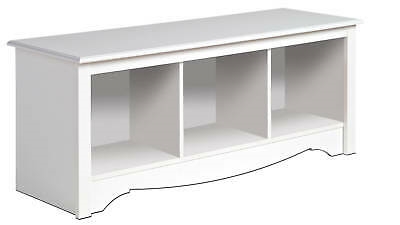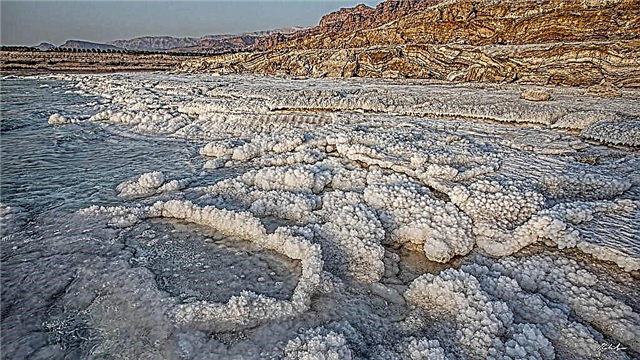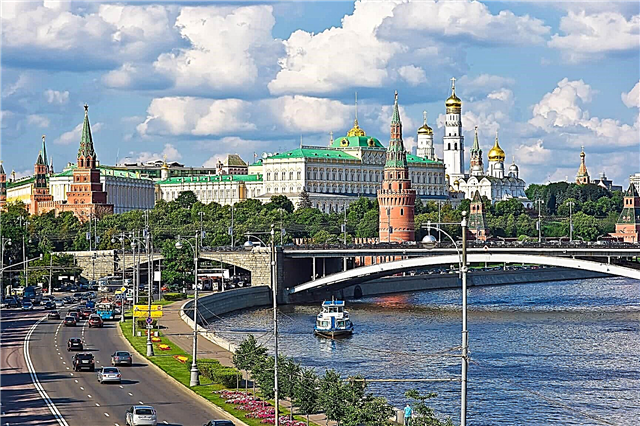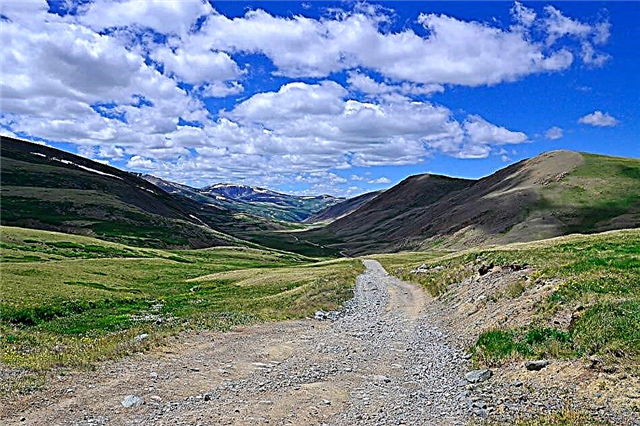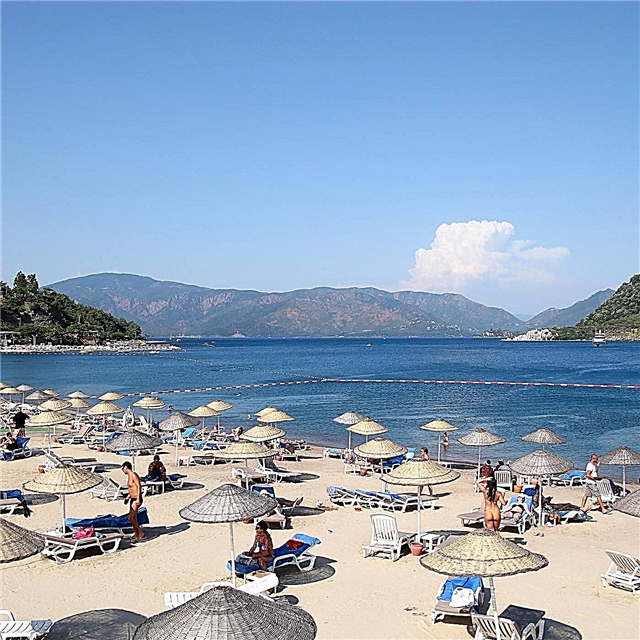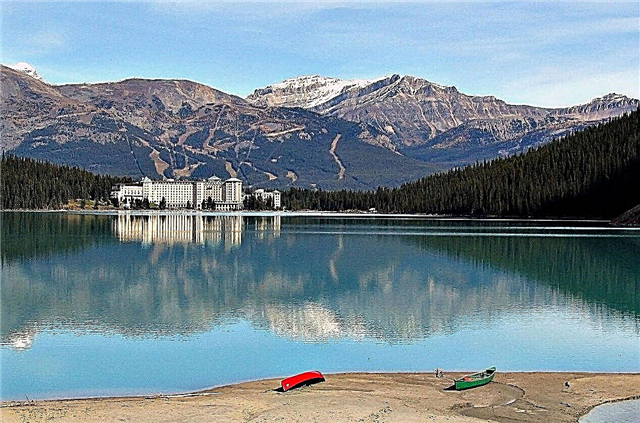Canada is home to fantastic landscapes that are simply breathtaking. And what the country really can boast of is its stunningly beautiful bodies of water. It is customary to call Canada the country of a thousand lakes, although in fact there are much more of them here - about 4 million. All of them are incredibly picturesque, the water in them is clearer than air.
Most of the lakes are located in mountainous areas, surrounded by snow-capped peaks, glaciers and dense forests. Louise, Moiraine, Emerald, Peyto - these azure lakes are the most recognizable in the world. Every year they attract numerous tourists and nature lovers. Equally famous are the Great Lakes, which lie on the border between the United States and Canada and represent the largest group of freshwater lakes on the planet.
The most famous and beautiful lakes in Canada
List, photos with names and descriptions of the best lakes!
Louise
A natural wonder of Banff National Park. Lies surrounded by Rocky Mountains and bright green forest, at an altitude of 1646 meters. The extraordinary emerald color of the water is due to the presence of rock particles brought into the lake by glaciers. Lake area - 0.8 km2... On the shore there is a 5-star hotel, a number of campgrounds and hostels, and a famous ski resort is located nearby. Hiking and cycling routes are organized around the reservoir. You can take a canoe boat excursion.

Moiraine
One of the most beautiful and most photographed lakes in the world. Visiting card of Canada. Its stunning landscapes can be found in many magazines and catalogs, on the Canadian currency, a screensaver for Windows, etc. It lies in the Valley of the Ten Peaks of the famous Banff Park, at an altitude of 1885 meters. The origin is glacial. Square - 0.5 km2... Routes have been laid out for tourists, it is better to move along them with an experienced guide. A hotel is built on the shore, there is a boat rental.

Big Bearish
The largest in Canada. Located in the Arctic Circle. Ice covered most of the year. Navigable, navigation is from July to October. Area - 31 thousand km2... The length of the coastline is 2.7 thousand km. There are many fish in the lake, but fishing is prohibited. Local beauties attract tourists who are not afraid of the cold climate - in winter temperatures down to -30 ° С, in summer + 10 ° С. In the last century, uranium and silver were mined on the lake. There are only 2 small villages in the vicinity.

Big Slave
A glacial lake lying in the Northwest Territories, surrounded by forests and tundra. Deepest in North America. Area - 28.5 thousand km2... The depth in Christie Bay reaches 614 meters. In the last century, gold, zinc and lead were mined here. In the 60s, a highway was built; before that, goods were transported on ice. Diamonds have been mined since the 90s. The lake is rich in fish; a rare species of American cranes lives nearby. The city of Yellowknife is located on the shore.

Huron
One of the Great Lakes, to the shores of which the state of Michigan and the province of Ontario have access. Area - 59.6 thousand km2... Famous for its islands. One of them, Manitoulin, is the largest lake island in the world. The huge bays of Saginaw and Georgian Bay are sometimes mistaken for full-fledged lakes. Part of the coastline is covered with forests, the other part is covered with dunes and sandy beaches. There are many sunken ships on the lake; an underwater reserve has been created to protect them.

Winnipeg
Located in the province of Manitoba, as part of the reservoir of the same name. Has an area of 24.3 thousand km2... Shallow, the average depth does not exceed 12 meters. A cascade of hydroelectric power stations has been built on the flowing river Nelson The dam of the upper one regulates the water level in Winnipeg. Taiga forests grow along the banks, there are limestone rocks, the caves of which are inhabited by bats. Amateur fishing is popular. There are 2 wildlife sanctuaries and several parks in the vicinity.

Small Slave
Lies in a tectonic glacial basin in the province of Alberta. Has an area of 1.2 thousand km2... The greatest depth reaches 21 meters. It is located on the migration route of numerous flocks of migratory birds, therefore, several parks and reserves have been created in the vicinity. There are 5 Indian reservations along the coast. Amateur and sport fishing is developing. A mink is bred. Camping sites are organized for tourists and vacationers.

Upper (Superior)
The largest in terms of area in the Great "Five" and among the freshwater lakes in the world. Located in Canada and the USA. Occupies an area of 82.7 thousand km2... The shores are indented, there are large bays and islands. There are many parks on the lake, a marine reserve has been created. The water is cold, even in summer it does not exceed 4 ° C, in winter it does not freeze due to frequent storms. The lake is rich in fish. Shipping. The major port is Thunder Bay. The southern part of the reservoir is known as the ship graveyard.

Ontario
The smallest in the "five" Great Lakes. "Ontario" for the Indians is "a lake of shining waters", the same name has the Canadian province. Lies in Canada and the United States. Has an area of 19.5 thousand km2 and a depth of up to 244 meters. There are more than a thousand islands on the lake, many parks and reserves. The Niagara River flows in. Shipping is developed all year round. Coastal ports - Hamilton, Toronto, Kingston. A popular destination for recreation, fishing, water sports.

O'Hara
Attraction in the Yoho National Park, British Columbia. Lies at an altitude of more than 2 thousand meters, in a fairly isolated alpine zone. In order not to disturb its fragile ecosystem, tourist access to this area is limited. Entry by cars and bicycles is prohibited. There are hiking trails where you can meet many animals - from a marmot to a grizzly bear. There is a hotel on the coast where you can relax and have a snack.

Peyto
This stunning natural wonder is located at an altitude of 1860 meters, in the Rocky Mountains of the famous Banff Park. The lake is very popular due to its unusual shape, resembling a wolf's head, as well as the color of the water. Glacial mountain flour comes from the surrounding glaciers into Peyto, thanks to which the water takes on a shade of thick turquoise with milk. Water area - 5.3 km2... It is famous for its fish variety. Comfortable recreation centers are located on the coast.

Waterton
Located in the south of Alberta and partly in the state of Montana. Covers an area of 9.4 km2... It is considered the deepest body of water in the Rocky Mountains. The maximum depths reach 150 meters. Waterton is a group of three lakes united by channels. It is part of the large National Park Waterton Lake - a UNESCO Biosphere Reserve. Subalpine and alpine nature in the vicinity of the lake is subject to protection. The village of the same name is located on the shore.

Bow
Located in Banff National Park, in the middle of the Rocky Mountains, at an altitude of 1920 meters. Covers an area of 2.8 km2... Powered by the Bow Glacier. The river, which originates in the southern part of the lake, has the same name. The maximum depth is 50 meters. The reservoir is rich in fish, mainly from the salmon family, but the catch is strictly limited. Popular with tourists. There are viewing platforms along the reservoir, a walking trail has been laid, and there is a hotel.

Clowayne
Lake with an area of 409 km2 in the Yukon Territory, near the border with Alaska. Lies at an altitude of 780 meters, within the national park of the same name. It contains the highest mountain in Canada - Logan, large glaciers, as well as a reservation for Indian communities. The lake is rich in fish, especially trout and whitefish. On the coast there are small settlements Destrakshen Bay, Berwash Landing, several tourist centers, and the Alaska Highway passes nearby.

Emerald
One of the main natural attractions of Yoho Park, in the middle of the Yukon Rocky Mountains. It is famous for its stunning emerald green water color, which is due to the presence of powdered limestone in it.Its high concentration is associated with the erosion of neighboring mountains. The water acquires a particularly rich shade in July. There is a 5 km long trail around the lake, along which benches are installed. There is a boat rental office on the shore.

Garibaldi
The deep blue waters of this lake attract numerous rowing, canoeing and hiking enthusiasts all year round. Located in British Columbia, in the park of the same name, surrounded by snow-capped mountains, glaciers, subalpine forests and meadows. It is of volcanic origin. Area - about 10 km2... The depth in some areas reaches 260 meters. Tourists have the opportunity to book a camping overnight to enjoy the beauty of the lake at dawn.

Hector
A small glacial lake in the southern Rocky Mountains, within Banff National Park. It was named after the British naturalist James Hector. Lies at an altitude of 1800 meters, in the valley of the Bow River, surrounded by high mountain ranges and glaciers. Has an area of 5.23 km2... Rich in fish, a national park license is required for fishing. There is a 4.5 km long tourist trail leading to the lake, which does not require special training.

Maline
One of the main adornments of the Jasper National Park, in the province of Alberta. It is an elongated body of blue glacial water surrounded by high peaks of the Rocky Mountains. Lies at an altitude of 1670 meters. The length is over 22 km. Square - 19.7 km2... The lake is fed by the river of the same name. The picturesque valley in which the reservoir is located has the same name. It is home to a lot of fish, the animal world in the vicinity is no less rich and diverse.

Joffrey Lakes
3 glacial lakes with incredible turquoise water color, some of the most beautiful in the world. Located in British Columbia, surrounded by snow-capped mountains and woodlands. They are located at different heights. The 11-kilometer pedestrian route starts from the Lower, then rises to the Middle and Upper lakes. Above the Upper Glacier lies a 20 thousand year old glacier. The ascent is not difficult, it is popular with tourists. There are waterfalls along the way.

Abraham
An artificial lake at the foot of the Rocky Mountains, at an altitude of 1340 meters, in the province of Alberta. Formed after the construction of a dam on the Saskatchewan River. Square - 53.7 km2... In winter, the uniqueness of the lake is given by bubbles of methane, frozen in the thickness of the ice, produced by plants at the bottom. Gas freezes at different depth levels, creating volumetric multilayer chains, columns, and colonnades. The lake is attractive for lovers of ecotourism, outdoor activities and fishing.

Agnes
A shallow mountain lake in the south of the country, in the province of Alberta. Located at an altitude of more than 2 thousand meters, in the territory belonging to the Banff National Park. The famous Lake Louise is 3.5 km away. Agnes is inferior to him in size, but not in the beauty of the surrounding landscapes. Reservoir area - 0.52 km2... Numerous hiking trails lead across the lake, including the glacier valley. A tea house was built on the shore, where tourists stop during their hikes.

Minnevanka
Another lake in Banff National Park, the largest on its territory. Square - 21.5 km2... Located at an altitude of 1.5 thousand meters. In the last century, it was used to generate electricity. Dams were built, which led to the flooding of the resort town of Minnevanka Landing, which today can only be seen by scuba divers. The lake is popular among hikers, cyclists, kayakers, fishermen. In winter, you can see the northern lights from here.

Berg
Located in British Columbia, in the Mount Robson Nature Reserve, named for the highest peak in the Rocky Mountains. Berg lies at the foot of this mountain, whose height is about 4 thousand meters. Its length is 2 km. Glaciers are sliding down from the top of the mountain, blocks of ice sometimes break off from them and in the form of icebergs fall into the lake. Therefore, the water has a beautiful turquoise hue. The popular hiking trail 22 km long Berg Lake Trail is laid to the lake.

Wedgmount
Lake with turquoise water in British Columbia, in the conservation area of Garibaldi Park, surrounded by snow-capped mountains. There is a steep 7 km long hiking trail leading to the lake, one of the most difficult in the park, with an ascent of more than 1200 meters. A spectacular waterfall is encountered along the way. There are about 20 wooden platforms around the lake, on which tents can be erected. There is also a small house for tourists, where you can take a break.

Spotted Lake (Kliluk)
It is one of the most unusual places in the world due to its outlandish mottled landscape. Located in British Columbia. The abnormal appearance is explained by the presence in the lake of an increased content of mineral substances. In summer, the water evaporates, revealing colored deposits of minerals in the form of circles, with liquid inside. The water has medicinal properties. The lake belongs to the Indians, who consider it sacred and protect. You can see Kliluk only through the fence.

Bennet
One part of the reservoir is located in the Yukon, the other in British Columbia. Named after New York publisher James Bennett, who sponsored a research expedition in 1883. During the gold rush, the lake served as an important staging post, where prospectors arrived from the vicinity, built boats for rafting down the Yukon River to gold reserves. There is a railway along the lake. Towns on the shore - Carcross, the abandoned Bennett.

Manitoba
Lake in the province of Manitoba, 75 km from its capital Winnipeg. Part of the ancient glacial lake Agassiz. The reservoir was opened in 1738. It gives rise to the Dauphin River. Occupies an area of approximately 4.5 thousand km2... It has a shallow depth, on average - 7 meters. There are campgrounds and recreation centers near the lake, and there are good beaches. Amateur fishing is well developed. Lots of waterfowl. There is an ornithological station on the shore.

Woollaston
The reservoir was discovered in 1800 and named after the English chemist William Wollasten. Located in the province of Saskatchewan. Area - 2.7 thousand km2... The uniqueness of Woollaston is that it is the largest lake in the world, lying on the border of the watershed and having flow into the basins of two large rivers - Churchill and Mackenzie. On the east bank is the small village of Woollaston Lake. There is a highway along the west coast. Recreational and sport fishing is popular.

Harrison
Located in British Columbia. Lies in a huge valley of glacial origin. It is surrounded by mountains on the east and west sides. There is a sandy beach area. The water is colder than in the surrounding lakes. But on several sites along the coast there are hot springs, on which the Harrison Hot Springs resort is located. Reservoir area - 218 km2... The maximum depth reaches 280 meters. Two large islands on the lake are Long and Ekou.

Okanagan
One of the lakes in British Columbia. Lies in the Okanagan Valley, which is famous for fertile lands, orchards and vineyards. It is part of an ancient glacial lake. Has an area of 350 km2... On the coast there is the Okanagan Mountain Park, the cities of Kelowna, Vernon, Penticton and others. The lake is attractive for fishermen and water sports enthusiasts. Among the local population, there are legends about the water monster Ogopogo, reminiscent of Loch Ness.


